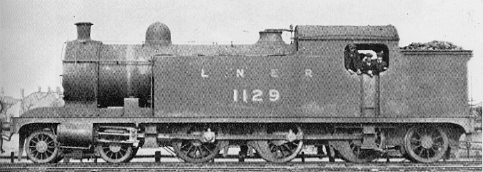The Raven A7 Pacific Tank Locomotives

Unlike the LNER's other 4-6-2T locomotives, the A7s were built for heavy mineral traffic, rather than to haul passenger services. They were designed as NER Class Y under Wilson Worsdell's tenure, but were not built until after Raven had taken over. The design was conceived in an attempt to avoid tender-first working on the short lines between collieries and port shipping staithes; and was developed from the T1 4-8-0T heavy shunters. However, they had larger boilers and smaller cylinders for higher working speeds. Only one batch of twenty was built, with construction occurring between 1910 and 1911.
When the A7s were originally constructed, two spare boilers were also constructed. These had Schmidt superheaters fitted in 1916, and were fitted to Nos. 1126 and 1175 in 1917 and 1919 respectively. The displaced saturated boilers were fitted to other A7s. Various boiler exchanges occurred, with superheating fitted to many of them. The end result was that seventeen out of the twenty A7s were fitted with superheaters between 1917 and 1932. From 1932, Robinson superheaters began to supercede the Schmidt type. Both superheater-fitted boiler types had longer smokeboxes than the original saturated boilers. In 1935, the A7 boilers were further modified to allow the interchange of boilers between the A6, A7, A8, H1, and T1 classes.
By the time the A7s entered LNER ownership with Grouping in 1923, the A7s had been relegated to shunting in the larger marshalling yards. Their power was invaluable when shunting heavy trains over the shunting hump.
In the 1930s, Nos. 1136 and 1175 were allocated to hauling chalk quarry trains from Hessle Quarry to Stoneferry Cement Works, in the Hull area.
Heavy mineral traffic declined after the end of World War II, and the A7s moved to the Hull area, except for Nos. 1181 and 1192 which stayed at Stockton. At Hull, the A7s replaced the old Hull & Barnsley (H&BR) types which were being withdrawn at that time. After the old H&BR locomotives were withdrawn, it was the turn of the A7s from 1951. The A7s became extinct in 1957.
Technical Details
The following details describe the superheated A7s when they entered LNER service in 1923. Three never had superheaters fitted, and between 1943 and 1952 fifteen had a 4ft 9in diameter boiler fitted.
| Cylinders (x3): | 16.5x26in. | |
| Motion: | Stephenson | 7.5in. piston valves |
| Boiler: | Max. Diameter: | 5ft 6in |
| Pressure: | 160psi | |
| Diagram No.: | 55 | |
| Heating Surface: | Total: | 1307.3 sq.ft. |
| Firebox: | 141 sq.ft. | |
| Superheater: | 258.3 sq.ft. | |
| Tubes: | 534 sq.ft. (90x 2in) | |
| Flues: | 374 sq.ft. (25x 5.25in) | |
| Grate Area: | 23 sq.ft. | |
| Wheels: | Leading: | 3ft 1.25in |
| Coupled: | 4ft 7.25in | |
| Trailing: | 3ft 9.25in | |
| Tractive Effort: | 26,140lb | (@ 85% boiler pressure) |
| Total Wheelbase: | 34ft 3in | |
| Length: | 43ft 10in | |
| Engine Weight: | (full) | 87 tons 10cwt |
| Max. Axle Load: | 19 tons 10cwt | |
| Water Capacity: | 2,300 gallons | |
| Coal Capacity: | 5 tons |
Preservation
The last A7 was withdrawn in 1955, and none survived into preservation.
Models
Little Engines sell a kit of the A7 in 4mm scale.